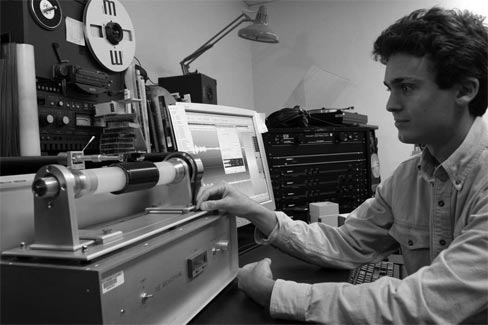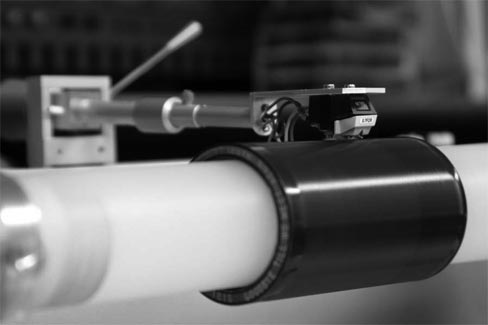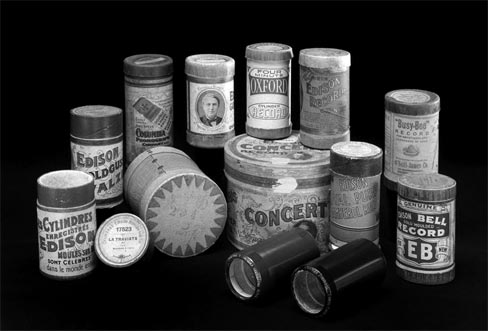Research Report
The Cylinder Preservation and Digitization Project at the University of California, Santa Barbara
by David Seubert
In 2002, staff at the Donald C. Davidson Library at the University of California, Santa Barbara (UCSB), completed a feasibility study to determine the best way of preserving the cylinder recordings in the library's collection and make them available online. During the study, the library digitized a sample set of 65 cylinders and placed them online, but public interest in the recordings was sufficiently strong that the library proceeded to make plans for digitizing all the cylinders in the collection. The library's collection was ideally suited for such a project: Not only was public interest high, but the need for preservation was critical, and the material presented few copyright problems.(1)
The library's collection of more than 7,000 cylinder recordings ranges from brown wax recordings from the 1890s to celluloid cylinders issued as late as 1928. Nearly all the cylinders are commercial entertainment recordings produced for public consumption (not field or ethnographic recordings, such as those held by many museums). The collection consists of approximately 5,500 cylinders issued by Thomas Edison in New Jersey and 760 titles issued by the Columbia Phonograph Company of New York.
Although eclipsed by the more popular disc recordings, cylinders played a pivotal role in the development of the early sound recording industry and are considered important historical artifacts. The repertoire recorded on early cylinders includes popular songs, vaudeville numbers, minstrelsy, comedic monologues, speeches, classical and operatic music, solo instrumental recordings, band music, and foreign and ethnic recordings. Although the content was not very different from the disc recordings produced by the Victor Talking Machine Company or the Columbia Phonograph Company—the two companies that released the greatest number of disc recordings in the first decades of the 20th century—most cylinder recordings are unique to the cylinder format. Many individual performers and groups, such as Billy Murray, Ada Jones, and various bands and vocal quartets, who recorded on discs also recorded on cylinders; however, most performances recorded first on cylinders were released in only that format.(2)
Edison had overseas recording operations in England, France, Germany, Mexico, and Cuba, and even recorded Chinese music in San Francisco, California. These recordings are some of the most obscure and overlooked material from the early recorded sound era. Other labels, such as Indestructible Records (Albany, New York), United States Phonograph Company (Cleveland, Ohio), and Lambert Company (Chicago), are represented in UCSB's collection in much smaller numbers, as are foreign cylinders made by Edison Bell and Sterling in England or Pathé in France.(Figure 1)
In 2003, UCSB received funding from the Institute of Museum and Library Services (IMLS) for a two-year project to catalog and digitize the recordings. Fortunately, Syracuse University's Belfer Audio Archive had already created basic MARC catalog records for their cylinder holdings (some 12,000 cylinder titles), and the project staff at UCSB were able to expand those records with subject headings, uniform titles, and more detailed performer information. Although certain popular cylinder titles appear in other public and private collections, about 25 percent of UCSB's holdings are not held by other public collections.
Once the cylinders were catalogued, the project staff sent them to the library's audio preservation laboratory. Lab technicians cleaned the celluloid and some of the earlier wax cylinders with a solution of water, detergent, ammonia, and a fungicide.(3) Most of the wax cylinders, however, especially those with mold damage, were not cleaned because the process removes the contour of the grooves, thus destroying any remaining sound. Oddly enough, the mold damage, if left intact, preserves the shape of the groove, resulting in better sound.
The lab played back the cylinders with an Archeophone designed by the French cylinder collector Henri Chamoux, digitized the audio at 44.1kHz with 24 bits of resolution using an English-made analog-to-digital converter, and saved the audio as a WAV file.(4)(Figures 2-3) The lab then filtered the master WAV file to reduce the pops, clicks, and crackles in the recordings and saved a second, restored WAV file.(5) It created service files from the restored files for patron access, including MP3 files for downloading and QuickTime (MOV) files for streaming.(6)
 |
Figure 2. A cylinder is prepared for transfer on the Archeophone. (Courtesy of UCSB Libraries.) |
 |
Figure 3. A Blue Amberol cylinder is transferred on the Archeophone using an electrical pickup and a custom stylus designed for cylinders. (Photo by Rod Rolle, courtesy of UCSB Libraries.) |
With cataloging metadata stored in an online catalog (OPAC) and digitized files stored on the library's mass storage system, the next step was to tie everything together in a website that not only enabled patrons to search, download, and stream audio files but also provided contextual and other information on cylinders and their place in music history. To that end, UCSB hired a computer programmer to create a website for searching the library catalog in real time and linking to the digitized content. The programmer configured the website to connect directly with the library OPAC so that any changes to the catalog records would immediately appear on the website.(7)
The website includes a historical overview of the various types of cylinders, along with several "streaming radio" programs that serve as a starting point for further research. With a little publicity from the media, particularly a New York Times article in March 2006, the site has attracted worldwide attention, and users have downloaded audio files more than 2.8 million times from the site.(8)
While the project has made significant contributions to the preservation and presentation of early sound recordings, much work remains to be done. According to current estimates, more than 75,000 titles were issued on cylinders, of which the UCSB collection represents less than 10 percent.(9) In addition, many fragile ethnographic cylinders in museum collections or early 78 rpm shellac recordings, although well preserved, are not readily accessible to researchers. The library hopes that future projects will help make more of the world's early audio heritage available online.
About the Author
David Seubert is the director of the Cylinder Preservation and Digitization Project at the Donald C. Davidson Library at the University of California, Santa Barbara.
Notes
1. Nearly all cylinders were recorded before 1923, so the underlying musical works on the cylinders have passed into the public domain. There was no copyright on sound recordings before 1972, so federal copyright does not apply; however, early recordings may be protected by state laws.
2. Some early Columbia recordings appeared in both disc and cylinder formats, but Victor never made cylinders. Edison shifted to disc recordings in later years, and cylinder issues after 1914 were dubbed from the disc masters.
3. The Library of Congress Preservation Directorate developed the cleaning formula for sound recordings. That formula was under review at the time of writing.
4. The Archeophone plays back a cylinder with a lightweight electrical pickup, thus minimizing potential damage. The Archeophone's electric motor is also more precise than a vintage machine. The speed is adjustable to the type of cylinder (most cylinders play at 90, 120, 144, or 160 rpm), and the machine will play all major sizes of cylinders, including the unusual 5" concert cylinders and the French "Salon" cylinders.
The lab used an analog-to-digital converter manufactured by CEDAR, an English company that makes equipment for audio restoration. The company is online at http://www.cedar-audio.com/, accessed May 10, 2007.
A WAV (Waveform audio format) file is an audio file format standard developed by Microsoft and IBM for storing audio digitally.
5. The lab added cataloging metadata to the restored WAV file headers and saved the original digitized files and the restored files on the library's mass storage system.
6. MP3 is a common encoding format for digital audio. MP3 is shorthand for MPEG-1 Audio Layer 3. The QuickTime .mov file format is a multimedia file format developed by Apple, Inc.
7. The library initially considered creating a separate searchable database for the website but had concerns about database maintenance, synchronization, and staffing.
The website was programmed in PHP, and queries are sent to the UCSB Library's OPAC through the Z39.50 gateway (a protocol for searching and retrieving data from remote library databases). The OPAC returns the cataloging data in Extensible Markup Language (XML) to the web server, where it is then formatted for display. For information on the Z39.50 gateway, see http://www.loc.gov/z3950/agency/, accessed May 11, 2007.
8. Jody Rosen, "How pop sounded before it popped," New York Times, March 19, 2006.
9. Bill Klinger, "Cylinder Record Output" unpublished spreadsheet, 2005.

